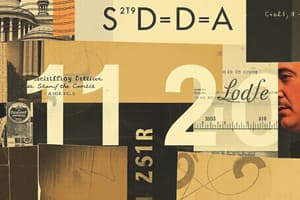Podcast
Questions and Answers
What is considered the foundation of all Sciences?
What is considered the foundation of all Sciences?
- Physics (correct)
- Biology
- Mathematics
- Chemistry
What does the international system (SI units) aim to achieve?
What does the international system (SI units) aim to achieve?
- Establish a global currency for scientific research
- Facilitate the teaching of complex scientific concepts
- Provide a universal system of equations
- Ensure consistent measurement understanding among scientists (correct)
What does a physical quantity describe?
What does a physical quantity describe?
- A specific theoretical concept
- The qualitative aspects of a phenomenon
- A characteristic measured quantitatively (correct)
- A behavior of matter under pressure
How was the unit of meter defined in 1960?
How was the unit of meter defined in 1960?
What defines the unit of time in the SI system?
What defines the unit of time in the SI system?
Which of the following is NOT a tip for learning Physics effectively?
Which of the following is NOT a tip for learning Physics effectively?
What does light travel a distance of in a vacuum in one second according to the meter's definition?
What does light travel a distance of in a vacuum in one second according to the meter's definition?
What describes the nature of Physics as a science?
What describes the nature of Physics as a science?
What is the reason for converting units in measurements?
What is the reason for converting units in measurements?
How many inches are in 3 meters? (1 meter = 39.37 inches)
How many inches are in 3 meters? (1 meter = 39.37 inches)
What is the role of significant figures in a measurement?
What is the role of significant figures in a measurement?
In terms of precision and accuracy, what does precision refer to?
In terms of precision and accuracy, what does precision refer to?
According to significant figure rules, how many significant figures are in the number 20,007?
According to significant figure rules, how many significant figures are in the number 20,007?
What is the degree of uncertainty based on the smallest division of a measurement of 1 mm?
What is the degree of uncertainty based on the smallest division of a measurement of 1 mm?
Which of the following statements is true about rounding numbers?
Which of the following statements is true about rounding numbers?
What is considered percent uncertainty in a measurement?
What is considered percent uncertainty in a measurement?
How many significant figures are in the number 20,007?
How many significant figures are in the number 20,007?
Which of the following numbers has two significant figures?
Which of the following numbers has two significant figures?
What rule applies to trailing zeros in a whole number when it has a decimal point?
What rule applies to trailing zeros in a whole number when it has a decimal point?
Which of these numbers has infinite significant figures?
Which of these numbers has infinite significant figures?
In the scientific notation 4.56 × 10^3, how many significant figures does 4.56 have?
In the scientific notation 4.56 × 10^3, how many significant figures does 4.56 have?
What is the significance of trailing zeros in the number 12,000.0?
What is the significance of trailing zeros in the number 12,000.0?
Which statement accurately describes leading zeros?
Which statement accurately describes leading zeros?
How many significant figures does the number 12.000 have?
How many significant figures does the number 12.000 have?
What should the answer be limited to when multiplying two numbers with significant figures?
What should the answer be limited to when multiplying two numbers with significant figures?
When performing addition, how do you determine the accuracy of the reported answer?
When performing addition, how do you determine the accuracy of the reported answer?
How many significant figures does the number 0.00057262 have?
How many significant figures does the number 0.00057262 have?
What is the significant figure count of the number 123.?
What is the significant figure count of the number 123.?
In the number 00001420, how many significant figures are present?
In the number 00001420, how many significant figures are present?
What is primarily ignored when counting significant figures in a number?
What is primarily ignored when counting significant figures in a number?
If two numbers 4.56 (3 significant figures) and 0.0089 (2 significant figures) are multiplied, what is the maximum number of significant figures in the result?
If two numbers 4.56 (3 significant figures) and 0.0089 (2 significant figures) are multiplied, what is the maximum number of significant figures in the result?
What should you do when adding numbers 45.67 (4 significant figures) and 0.534 (3 significant figures)?
What should you do when adding numbers 45.67 (4 significant figures) and 0.534 (3 significant figures)?
What is the definition of 1 second in terms of cesium atom cycles?
What is the definition of 1 second in terms of cesium atom cycles?
What is the mass of the standard kilogram defined by?
What is the mass of the standard kilogram defined by?
How do you convert 763.0 mi/h to meters per second?
How do you convert 763.0 mi/h to meters per second?
What is the volume of the First Star of Africa diamond in cubic centimeters?
What is the volume of the First Star of Africa diamond in cubic centimeters?
What is the conversion factor to change kilograms to pounds?
What is the conversion factor to change kilograms to pounds?
How dense is a solution if the mass of 20.0 mL is 36.8 g?
How dense is a solution if the mass of 20.0 mL is 36.8 g?
What is 65.0ºC converted to Fahrenheit?
What is 65.0ºC converted to Fahrenheit?
What prefix represents 10^9 in the metric system?
What prefix represents 10^9 in the metric system?
Flashcards are hidden until you start studying
Study Notes
General Physics Overview
- Physics studies phenomena in the universe and explains the nature of surrounding things.
- It serves as the foundational discipline for all sciences and emphasizes experimental methods.
Units of Measurement
- Physical quantities describe phenomena quantitatively and require consistent units for clarity.
- The International System (SI Units) standardizes measurements worldwide, including length, time, and mass.
Definitions of Standard Units
- Length: Defined as the distance light travels in a vacuum in 1/299,792,458 seconds, equating to exactly 1 meter.
- Time: One second is the duration of 9,192,631,770 cycles of cesium atomic transitions.
- Mass: Defined by the mass of a platinum-iridium cylinder at the International Bureau of Weights and Measures, with 1 kilogram standardized.
Unit Conversion
- Converting units is essential for clarity in communication of measurements.
- Examples include converting miles per hour to meters per second or cubic inches to cubic centimeters.
- Familiarity with conversion factors aids in translation between measurement systems.
Measurement Uncertainty
- Every measurement has inherent uncertainty, often related to the smallest division of the measuring instrument.
- Understanding uncertainty is essential for accurate reporting and interpretation of experimental results.
Significant Figures
- Significant figures indicate the precision of measurements, with specific rules governing which digits count.
- Non-zero digits are significant, as well as zeros between non-zero digits; leading zeros are not significant.
- Trailing zeros in decimal numbers are significant while those in whole numbers without decimals are ambiguous unless specified.
Rounding and Calculating with Significant Figures
- Rounding rules dictate that numbers 1-4 round down, while 5-9 round up.
- For multiplication/division, the result should reflect the lowest number of significant figures in any of the numbers used.
- For addition/subtraction, the answer should be reported with the least precise decimal place common among the numbers involved.
Key Academic Tips for Success
- Understand personal learning styles to tailor study methods effectively.
- Allocate consistent study time and practice solving various physics problems to enhance problem-solving skills.
Studying That Suits You
Use AI to generate personalized quizzes and flashcards to suit your learning preferences.




